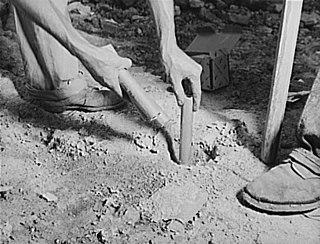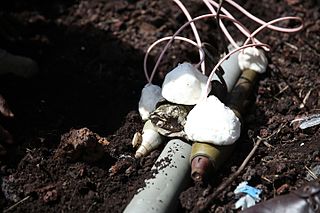
RDX (abbreviation of "Research Department eXplosive" or Royal Demolition eXplosive) or hexogen, among other names, is an organic compound with the formula (CH2N2O2)3. It is white, odorless, and tasteless, widely used as an explosive. Chemically, it is classified as a nitroamine alongside HMX, which is a more energetic explosive than TNT. It was used widely in World War II and remains common in military applications.

Dynamite is an explosive made of nitroglycerin, sorbents, and stabilizers. It was invented by the Swedish chemist and engineer Alfred Nobel in Geesthacht, Northern Germany, and was patented in 1867. It rapidly gained wide-scale use as a more robust alternative to the traditional black powder explosives. It allows the use of nitroglycerine's favorable explosive properties while greatly reducing its risk of accidental detonation.

An explosive is a reactive substance that contains a great amount of potential energy that can produce an explosion if released suddenly, usually accompanied by the production of light, heat, sound, and pressure. An explosive charge is a measured quantity of explosive material, which may either be composed solely of one ingredient or be a mixture containing at least two substances.

Plastic explosive is a soft and hand-moldable solid form of explosive material. Within the field of explosives engineering, plastic explosives are also known as putty explosives or blastics.

Trinitrotoluene, more commonly known as TNT (and more specifically 2,4,6-trinitrotoluene, and by its preferred IUPAC name 2-methyl-1,3,5-trinitrobenzene), is a chemical compound with the formula C6H2(NO2)3CH3. TNT is occasionally used as a reagent in chemical synthesis, but it is best known as an explosive material with convenient handling properties. The explosive yield of TNT is considered to be the standard comparative convention of bombs and asteroid impacts. In chemistry, TNT is used to generate charge transfer salts.

2,4,6-Trinitrophenylmethylnitramine or tetryl (C7H5N5O8) is an explosive compound used to make detonators and explosive booster charges.

Picric acid is an organic compound with the formula (O2N)3C6H2OH. Its IUPAC name is 2,4,6-trinitrophenol (TNP). The name "picric" comes from Greek: πικρός (pikros), meaning "bitter", due to its bitter taste. It is one of the most acidic phenols. Like other strongly nitrated organic compounds, picric acid is an explosive, which is its primary use. It has also been used as medicine (antiseptic, burn treatments) and as a dye.

Ammonium nitrate is a chemical compound with the formula NH4NO3. It is a white crystalline salt consisting of ions of ammonium and nitrate. It is highly soluble in water and hygroscopic as a solid, although it does not form hydrates. It is predominantly used in agriculture as a high-nitrogen fertilizer.

Amatol is a highly explosive material made from a mixture of TNT and ammonium nitrate. The British name originates from the words ammonium and toluene. Similar mixtures were known as Schneiderite in France. Amatol was used extensively during World War I and World War II, typically as an explosive in military weapons such as aircraft bombs, shells, depth charges, and naval mines. It was eventually replaced with alternative explosives such as Composition B, Torpex, and Tritonal.

A shell, in a modern military context, is a projectile whose payload contains an explosive, incendiary, or other chemical filling. Originally it was called a bombshell, contrasting with solid shells used for early rifled artillery, but "shell" has come to be unambiguous in a military context. A shell can hold a tracer.

Tritonal is a mixture of 80% TNT and 20% aluminium powder, used in several types of ordnance such as air-dropped bombs. The aluminium increases the total heat output and hence impulse of the TNT – the length of time during which the blast wave is positive. Tritonal is approximately 18% more powerful than TNT alone.

Torpex is a secondary explosive, 50% more powerful than TNT by mass. Torpex comprises 42% RDX, 40% TNT and 18% powdered aluminium. It was used in the Second World War from late 1942, at which time some used the names Torpex and RDX interchangeably, much to the confusion of today's historical researchers. Torpex proved to be particularly useful in underwater munitions because the aluminium component made the explosive pulse last longer, which increased the destructive power. Besides torpedoes, naval mines, and depth charges, Torpex was only used in the Upkeep, Tallboy and Grand Slam bombs as well as the drones employed in Operation Aphrodite. Torpex has long been superseded by H6 and Polymer-bonded explosive (PBX) compositions. It is regarded as obsolete and Torpex is unlikely to be encountered except in old munitions or unexploded ordnance, although a notable exception to this is the Sting Ray lightweight torpedo, which as of October 2020 remains in service with the Royal Navy and several foreign militaries. The German equivalent of Torpex was Trialen.

Naval Surface Warfare Center, Indian Head Division is a United States Navy installation in Charles County, Maryland. Part of Naval Sea Systems Command (NAVSEA), it is one of ten divisions of the Naval Surface Warfare Center (WFC). Its mission is to research, develop, test, evaluate, and produce energetics.

TATB, triaminotrinitrobenzene or 2,4,6-triamino-1,3,5-trinitrobenzene is an aromatic explosive, based on the basic six-carbon benzene ring structure with three nitro functional groups (NO2) and three amine (NH2) groups attached, alternating around the ring.
A World War I explosive factory, which was to be later known as NEF Pembrey was built, by Nobel's Explosives, with British Government approval, near the village of Pembrey, Carmarthenshire, Wales. The factory was built on a site consisting of mainly sandhills and sand dunes to provide some protection against damage caused by an explosion. Its main product was TNT (Trinitrotoluene) used for shell filling. The same site was used in World War II to build another explosive factory ROF Pembrey, which also made TNT.
Minol is a military explosive developed by the Admiralty early in the Second World War to augment supplies of trinitrotoluene (TNT) and RDX, which were in short supply. The aluminium component in Minol significantly prolongs the explosive pulse, making it ideal for use in underwater naval weapons where munitions with a longer explosive pulse are more destructive than those with high brisance. Initially, three Minol formulas were used. All percentages shown are by weight:
Oxygen balance is an expression that is used to indicate the degree to which an explosive can be oxidized, to determine if an explosive molecule contains enough oxygen to fully oxidize the other atoms in the explosive. For example, fully oxidized carbon forms carbon dioxide, hydrogen forms water, sulfur forms sulfur dioxide, and metals form metal oxides. A molecule is said to have a positive oxygen balance if it contains more oxygen than is needed and a negative oxygen balance if it contains less oxygen than is needed.
Explosive materials are produced in numerous physical forms for their use in mining, engineering, or military applications. The different physical forms and fabrication methods are grouped together in several use forms of explosives.

Potassium picrate, or potassium 2,4,6-trinitrophenolate, is an organic chemical, a picrate of potassium. It is a reddish yellow or green crystalline material. It is a primary explosive. Anhydrous potassium picrate forms orthorhombic crystals.

















